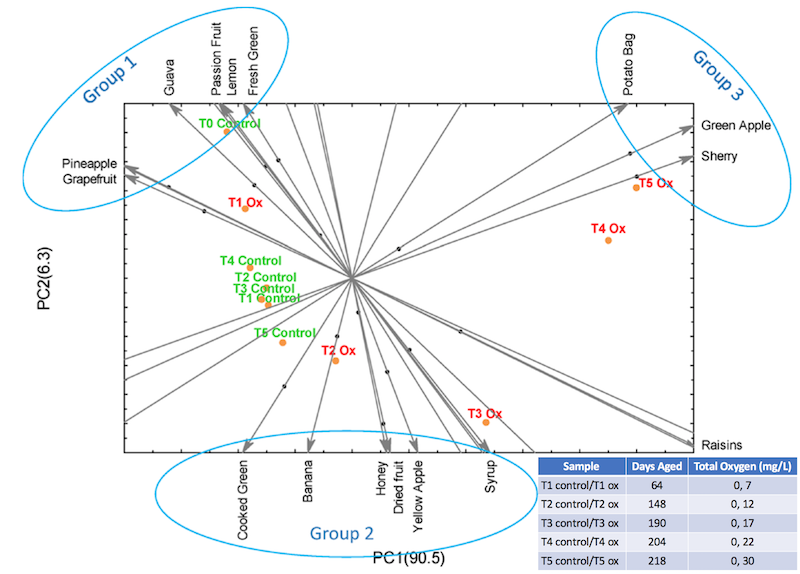Wine connoisseurs know that there is a big difference between drinking wine from a newly-opened bottle versus from one that has been previously opened. The reason is oxygen. Oxygen is the enemy of most wine.
Once inside, oxygen can combine with other compounds (in a process called "oxidation"), and it can provide fuel for bacteria to produce foul-tasting molecules.
This is particularly true for white wine. Sauvignon blanc, which is often a fruity wine, requires just the right amount of oxygen to please the critics. An insufficient amount of oxygen can cause a white wine to have hints of cabbage (due to methyl mercaptan) or rotten eggs (due to hydrogen sulfide). Too much oxygen, on the other hand, causes the wine to taste of green apples or curry.
In order to determine how aging and oxygen change white wine over time, a team of researchers subjected Sauvignon blanc to a seven-month-long experiment. One bottle, which served as the control, did not have any added oxygen. Five experimental bottles had increasing amounts of oxygen added. Samples were taken at various time points from the control bottle and one of the experimental bottles. These samples were then subjected to chemical analyses and taste tests.

Their results showed that the control wine (T0 control), immediately after being produced, had a strong fruity flavor (Group 1 characteristic). Understandably, this wine was given the freshest rating since it was sampled prior to bottling.
However, even in the absence of oxygen, the natural aging process caused the wine's flavor to change toward less desirable Group 2 characteristics (T1 to T4 controls). By seven months (T5 control), aging had changed the wine even further toward Group 2. None of the control wines had the unpleasant Group 3 traits.
Adding oxygen made a gigantic difference. Though it was exposed to oxygen, T1 ox was actually rated as fresher and fruitier than the T1 to T5 controls. Beyond that, oxygen essentially accelerated the aging process. For instance, the T2 oxidized wine (aged 148 days) was similar to the T5 control (aged 218 days). Wines aged more than 200 days (T4 ox and T5 ox) took on the undesirable Group 3 characteristics.
So, why would the slightly oxidized T1 wine taste better than the control? The authors suspect that T1 ox had the perfect amount of oxygen -- i.e., enough to neutralize nasty sulfur-containing molecules but not so much as to destroy the fruity ones*.
Understanding the complex chemistry of wine is obviously important for vintners. As this experiment shows, oxygen content greatly influences both the flavor and shelf-life of Sauvignon blanc.
*Note: The team's experimental design did not allow them to assess how T1 ox's flavor profile would change beyond 64 days. So, all that can be concluded from this experiment is that taste testers preferred a Sauvignon blanc that had been aged about two months in the presence of 3 mg/L oxygen.
Source: Carien Coetzee, Elizma Van Wyngaard, Katja Šuklje, Antonio C. Silva Ferreira, and Wessel J. du Toit. "Chemical and Sensory Study on the Evolution of Aromatic and Nonaromatic Compounds during the Progressive Oxidative Storage of a Sauvignon blanc Wine." J. Agric. Food Chem. 64 (42): 7979–7993. Published: 17-October-2016. DOI: 10.1021/acs.jafc.6b02174




